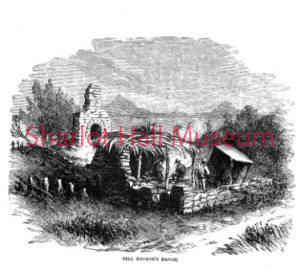By C. Gilbert Storms
Soon after the Gadsden Purchase was ratified in April 1854, Americans began settling in the Santa Cruz and Sonoita Creek valleys of southern Arizona. Popular Western travel writer John Ross Browne wrote that by 1861 the Santa Cruz Valley was well populated between Tucson and the Calabasas ranch, fifteen miles south of Tubac. But when he visited the area just three years later, Browne found that the ranches and mine sites of the area were deserted and in ruins. The immediate cause of this sudden reversal was raiding by Western and Chiricahua Apaches. But early relations between Apaches and Americans in the Southwest had been non-violent. So how did American settlement in the region come to be wiped out by Apache raids?
 Pete Kitchen may have been the first American to settle on the Santa Cruz River, establishing a ranch there in 1854. He was followed by other pioneers. The Rowlett, Struby, Rhodes, Canoa, Sópori, and Reventon ranches were strung along the Santa Cruz Valley, and along the Sonoita Creek the ranches and farms of Findlay, B. C. Marshall, Ash, John Ward, Ellet and Henry Titus, Felix Grundy Ake, Wadsworth, and Ochoa. James “Paddy” Graydon operated a tavern called Casa Blanca near the head of the creek, and three miles farther north stood the army post at Fort Buchanan. Fort Breckinridge was established on Aravaipa Creek, at the head of the San Pedro Valley.
Pete Kitchen may have been the first American to settle on the Santa Cruz River, establishing a ranch there in 1854. He was followed by other pioneers. The Rowlett, Struby, Rhodes, Canoa, Sópori, and Reventon ranches were strung along the Santa Cruz Valley, and along the Sonoita Creek the ranches and farms of Findlay, B. C. Marshall, Ash, John Ward, Ellet and Henry Titus, Felix Grundy Ake, Wadsworth, and Ochoa. James “Paddy” Graydon operated a tavern called Casa Blanca near the head of the creek, and three miles farther north stood the army post at Fort Buchanan. Fort Breckinridge was established on Aravaipa Creek, at the head of the San Pedro Valley.
Small mining companies opened silver mines in the Santa Rita Mountains and west of the river. They included Charles D. Poston’s Sonora Exploring and Mining Company, the Santa Rita Mining Company, Sylvester Mowry’s Patagonia Mine, and the Sópori Land and Mining Company. In just a few years, an integrated economy developed among the Americans. Ranchers and farmers subsisted by supplying beef, hay, and other crops to the forts and mines and to the growing settlement at Tucson. Ranchers, farmers, and mine operators depended upon the army for protection from Apache raids.
Of course, there were other residents of southern Arizona—Mexicans, Apaches, and the Tohono O’odham, all of whom had lived in southern Arizona for centuries. In 1860 Tucson and Tubac had many more Mexican residents than Americans or Europeans, and almost all the mine and ranch workers in the Santa Cruz Valley and Santa Rita Mountains were Mexican. Americans, Mexicans, and Native Americans all co-existed in an uneasy interdependence that sometimes erupted into violence.
There was little raiding by Apaches in southern Arizona between 1854 and 1857. But as American settlement increased, the American presence became more irritating to Apaches and the targets for raiding more numerous and inviting. Raiding increased, and by late 1858 it had become a plague, resulting in stolen cattle, horses, and mules from ranches and mines in the Santa Cruz and Sonoita Creek valleys.
 Apaches raided in southern Arizona in the late 1850s mainly for subsistence and seldom took lives. But this changed after the “Bascom incident” of February 4-8, 1861, when Cochise and some of his family were taken prisoner by Lt. George N. Bascom and the U.S. Army at Apache Pass, and six Apaches were later hanged, Cochise’s brother among them. The Apache violence that followed was not driven solely by the Bascom debacle, but Apache raids afterward were clearly meant to drive out Americans and often involved the deaths of soldiers and civilians.
Apaches raided in southern Arizona in the late 1850s mainly for subsistence and seldom took lives. But this changed after the “Bascom incident” of February 4-8, 1861, when Cochise and some of his family were taken prisoner by Lt. George N. Bascom and the U.S. Army at Apache Pass, and six Apaches were later hanged, Cochise’s brother among them. The Apache violence that followed was not driven solely by the Bascom debacle, but Apache raids afterward were clearly meant to drive out Americans and often involved the deaths of soldiers and civilians.
After the army abandoned Forts Buchanan and Breckinridge in July 1861 and withdrew to New Mexico to protect against an expected Confederate invasion from Texas, the Apaches were unopposed. Southern Arizona quickly depopulated of American settlers, and the relentless blood-letting between Apaches and Americans dragged on for another twenty-five years until Geronimo and his band surrendered to General Nelson Miles in 1886.
When the regular army returned to Arizona in 1865, most of the old ranches and mines of the Santa Cruz Valley were not taken up by their former owners. Today, the precise location of many of the old settlements is not known. They are “lost ranches,” and few signs remain of the ranches or the deadly struggles that occurred there between settlers and Apaches.
Dr. Gil Storms is a retired educator who researches and writes on Southwestern history and literature. This article is a preview of a presentation he will make at the Fifteenth Annual Western History Symposium that will be held at the Prescott Centennial Center on August 4th. The Symposium is co-sponsored by the Sharlot Hall Museum and the Prescott Corral and is open to the public free of charge. For more details, call the Museum at 445-3122 or visit the sponsors’ websites at www.sharlothallmuseum.org and www.prescottcorral.org.
“Days Past” is a collaborative project of the Sharlot Hall Museum and the Prescott Corral of Westerners International (www.prescottcorral.org). This and other Days Past articles are also available at https://archives.sharlothallmuseum.org/articles/days-past-articles/l. The public is encouraged to submit proposed articles and inquiries to dayspast@sharlothallmuseum.org. Please contact SHM Library & Archives reference desk at 928-445-3122 Ext. 2, or via email at archivesrequest@sharlothallmuseum.org for information or assistance with photo requests.


